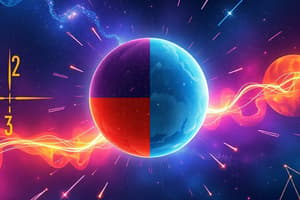Podcast
Questions and Answers
Which of the following pairs of fractions are equivalent?
Which of the following pairs of fractions are equivalent?
- $ rac{4}{6}$ and $ rac{6}{8}$
- $ rac{2}{3}$ and $ rac{3}{4}$
- $ rac{1}{2}$ and $ rac{5}{10}$ (correct)
- $ rac{2}{5}$ and $ rac{4}{15}$
What is the least common multiple (LCM) of 12 and 18?
What is the least common multiple (LCM) of 12 and 18?
- 24
- 36 (correct)
- 6
- 72
Which of the following fractions is the largest?
Which of the following fractions is the largest?
- $ rac{5}{8}$
- $ rac{7}{10}$ (correct)
- $ rac{13}{20}$
- $ rac{3}{5}$
Identify the pair containing one proper fraction and one improper fraction.
Identify the pair containing one proper fraction and one improper fraction.
Which set of fractions are dissimilar fractions?
Which set of fractions are dissimilar fractions?
Flashcards
Similar Fractions
Similar Fractions
Fractions with the same denominator.
Dissimilar Fractions
Dissimilar Fractions
Fractions with different denominators.
Least Common Multiple (LCM)
Least Common Multiple (LCM)
The smallest number that is a multiple of two or more numbers.
Factors
Factors
Signup and view all the flashcards
Equivalent Fractions
Equivalent Fractions
Signup and view all the flashcards
Study Notes
Kinds of Fractions
- A fraction represents a part of a whole or, more generally, any number of equal parts
- It is written as a/b, where 'a' is the numerator and 'b' is the denominator
- Proper fractions: Numerator is less than the denominator (e.g., 2/3)
- Improper fractions: Numerator is greater than or equal to the denominator (e.g., 5/2)
- Mixed fractions: Combination of a whole number and a proper fraction (e.g., 1 1/2)
- Complex fractions: A fraction where the numerator, denominator, or both contain fractions (e.g., (1/2)/(3/4))
- Equivalent fractions: Fractions that represent the same value, even if they look different (e.g., 1/2 and 2/4)
Similar and Dissimilar Fractions
- Similar fractions: Fractions having the same denominator (e.g., 2/7, 3/7, 5/7)
- Dissimilar fractions: Fractions having different denominators (e.g., 1/3, 2/5, 3/4)
- Converting dissimilar fractions to similar fractions involves finding a common denominator
- The common denominator is usually the Least Common Multiple (LCM) of the original denominators
- Once fractions have a common denominator, they can be easily added or subtracted
- Example: To compare 1/3 and 2/5, convert them to 5/15 and 6/15 respectively
Least Common Multiple (LCM)
- The Least Common Multiple (LCM) of two or more numbers is the smallest positive integer that is divisible by each of the numbers
- Methods to find the LCM:
- Listing multiples: List multiples of each number until a common multiple is found
- Prime factorization: Find the prime factors of each number, then take the highest power of each prime factor and multiply them
- Division method: Divide the numbers by common prime factors until all quotients are 1, then multiply the divisors
- Example: LCM of 4 and 6
- Multiples of 4: 4, 8, 12, 16, 20, 24...
- Multiples of 6: 6, 12, 18, 24, 30...
- The LCM of 4 and 6 is 12
- Example: Using prime factorization to find the LCM of 12 and 18
- 12 = 2^2 * 3
- 18 = 2 * 3^2
- LCM = 2^2 * 3^2 = 4 * 9 = 36
Factors
- A factor of a number is an integer that divides the number evenly, leaving no remainder
- Every number has at least two factors: 1 and the number itself
- To find factors of a number, check which integers divide the number without a remainder
- Example: Factors of 12: 1, 2, 3, 4, 6, 12
- Prime factors are factors that are prime numbers (numbers divisible only by 1 and themselves)
- Prime factorization is expressing a number as a product of its prime factors
- Example: Prime factorization of 30: 2 x 3 x 5
Equivalent Fractions
- Equivalent fractions represent the same value, but have different numerators and denominators
- To create equivalent fractions, multiply (or divide) both the numerator and denominator by the same non-zero number
- Example: 1/2 is equivalent to 2/4, 3/6, 4/8, etc. (multiply by 2, 3, 4 respectively)
- Simplifying fractions: Divide both numerator and denominator by their greatest common factor (GCF) to get the simplest equivalent fraction
- To check if two fractions are equivalent, cross-multiply. If the products are equal, the fractions are equivalent
- Example: Is 2/3 equivalent to 4/6? 26 = 12 and 34 = 12. Yes, they are equivalent
Comparing Fractions
- To compare fractions, it's easiest if they have the same denominator (similar fractions)
- If denominators are the same, the fraction with the larger numerator is greater
- If denominators are different (dissimilar fractions), find a common denominator (usually the LCM)
- Convert each fraction to an equivalent fraction with the common denominator
- Compare the numerators; the fraction with the larger numerator is greater
- If the numerators are the same, the fraction with the smaller denominator is greater (because each part represents a larger portion of the whole)
- Example: Compare 3/4 and 5/6
- LCM of 4 and 6 is 12
- 3/4 = 9/12
- 5/6 = 10/12
- 10/12 is greater than 9/12, so 5/6 is greater than 3/4
- Comparing fractions to 1/2:
- If the numerator is more than half the denominator, the fraction is greater than 1/2
- If the numerator is less than half the denominator, the fraction is less than 1/2
- Comparing fractions to 1:
- If the numerator is less than the denominator, the fraction is less than 1
- If the numerator is equal to the denominator, the fraction is equal to 1
- If the numerator is greater than the denominator, the fraction is greater than 1
Studying That Suits You
Use AI to generate personalized quizzes and flashcards to suit your learning preferences.




